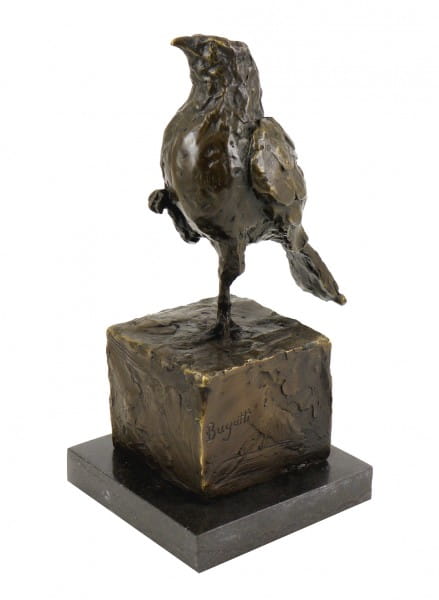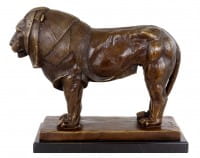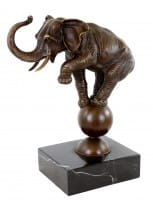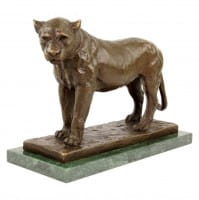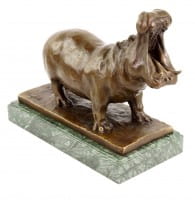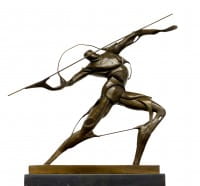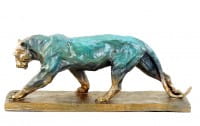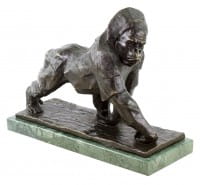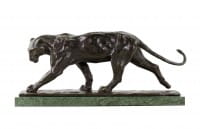Prices incl. VAT, free shipping worldwide
Ready to ship today,
Delivery time appr. 3-6 workdays










Product description
"Rembrandt Bugatti Sculptures - Proud Bird - Bronze Statue"
| Height | 20 cm |
| Width | 13 cm |
| Length | 9 cm |
| Weight | 1,5 kg |
Bronze Sculpture on Marble - Proud Bird - Signed Rembrandt Bugatti
Rembrandt Bugatti was born on October 16, 1884, in Milan, Italy, into a family of artists and engineers. His father, Carlo Bugatti, was a celebrated furniture designer, and his older brother, Ettore Bugatti, would become famous as a luxury car manufacturer. But Rembrandt found his unique voice not in objects or machines, but in animals. From an early age, he showed an intense sensitivity toward the natural world, spending hours observing and sketching live animals in the zoological gardens of Milan and later Antwerp and Paris. This intuitive bond with animals, combined with extraordinary technical skill, made Rembrandt Bugatti sculptures instantly recognizable for their truthfulness, energy, and deep psychological presence.
The Birth of a Bronze Icon
Created around 1908 and cast in bronze, “Proud Bird” is a quintessential example of Rembrandt Bugatti’s artistic vision. The sculpture portrays a bird—elegant, alert, and self-contained—standing with upright posture atop a rugged, textural pedestal. Its form is both anatomically correct and emotionally suggestive. The bird's neck stretches confidently, and its beak points upward as if it were surveying the air with inner resolve. This is not a passive depiction but a character study—one that captures the silent dignity of wild creatures as Bugatti knew them from life. In this way, “Proud Bird” becomes much more than a decorative object; it is a fragment of the natural world, made enduring through bronze.
A Language of Form and Texture
One of the most distinctive features of Rembrandt Bugatti sculptures is the tactile energy of their surfaces. Unlike the polished finish favored by academic sculptors of his time, Bugatti worked directly in plastiline clay, leaving finger marks, sculptural gestures, and dynamic surfaces intact. In “Proud Bird”, this modeling technique breathes vitality into the subject. The feathers are not overdefined but suggested in a rhythm of ridges and indentations, allowing the bronze to shimmer with movement as light crosses its surface. The irregularities of the base reflect the earth or perch, giving the bird a grounded, contextual presence that feels spontaneous yet entirely composed.
The Poetry of Stillness
Bugatti’s genius lay in his ability to find monumental stillness in living forms. The bird in “Proud Bird” does not move, yet it feels as if it could at any moment. It is captured in a moment of poised calm, embodying both readiness and rest. The sculpture becomes a meditation on presence—a visual echo of what Bugatti himself often described as “the inner being” of animals. Such emotional clarity is rare in bronze, a material that typically suggests permanence more than fragility. But in the hands of Rembrandt Bugatti, bronze becomes a living skin for something tender, watchful, and real.
A Signature of Artistic Integrity
The block on which the bird stands bears the unmistakable inscription: Bugatti. This signature is not simply a mark of authorship, but a symbol of one of the most gifted animal sculptors in European art history. Rembrandt Bugatti sculptures were never mass-produced; they were made with conviction, cast with precision, and released in small editions. Each one carries the intimacy of the artist’s own hand and the purity of his vision. “Proud Bird”, with its modest size and emotional intensity, is one of those rare objects that embody the spirit of its creator with haunting fidelity.
A Short Life, an Enduring Voice
Rembrandt Bugatti’s life was tragically short. After working as an orderly in a military hospital during World War I, he fell into depression and took his own life in Paris in 1916, at just 31 years old. Yet in that brief time, he created a body of work that continues to resonate across generations. His sculptures are not only admired in private collections but housed in major institutions such as the Musée d'Orsay in Paris and the National Gallery of Modern Art in Rome. “Proud Bird” stands as a quiet but powerful monument to that legacy—a fragment of bronze that carries the breath of life, the weight of stillness, and the memory of one of modern sculpture’s most sensitive souls.
Our advantages
free shipping
Worldwide free shipping
14 days money back
You can cancel your order
within 14 days
secure payment services
Paypal, Master Card, Visa, American Express and more










